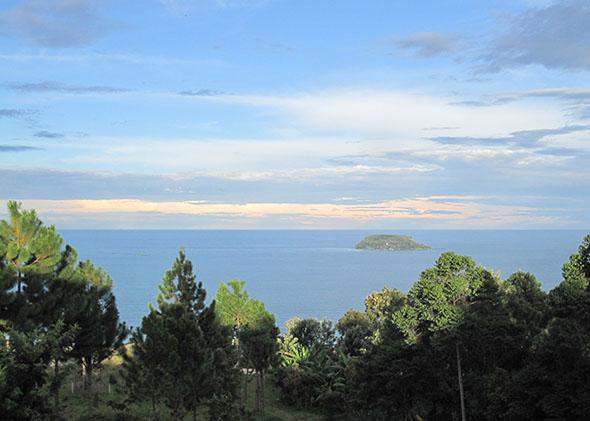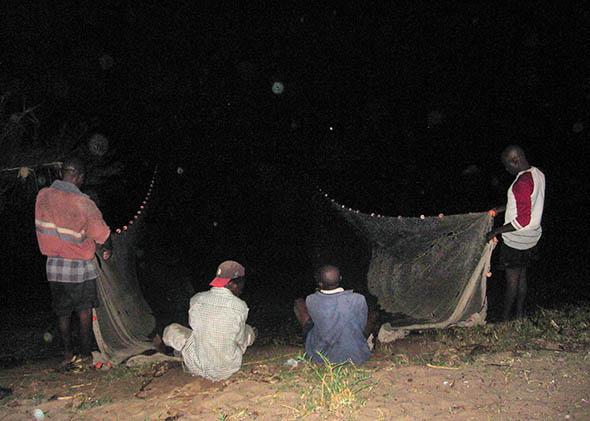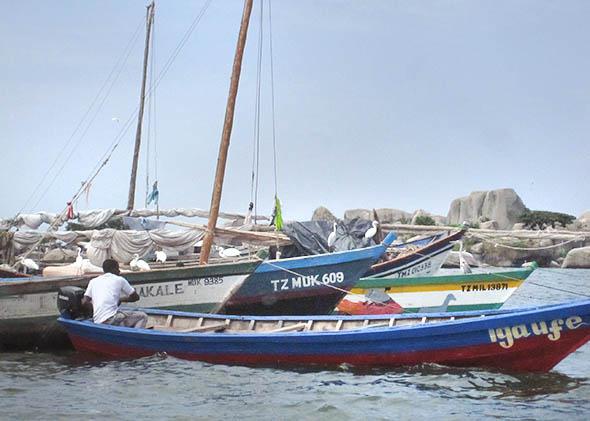UKEREWE, Tanzania—The night is clear and cool, the pale light of the full moon shimmering on the black water of Lake Victoria. As we emerge from the bay and round a small headland, Hamisi, the crew’s leader, stands in the bow and shines a small flashlight toward a cove. Two of the other men paddle vigorously, their wooden oars the shape of long spears. The third uses a cut-off jerry can to bale water from the hull of the leaky wooden canoe.
Hamisi is looking for a place to spend the night, but he is also keeping an eye out for government patrols on the beaches. Normally the patrols operate only in the daytime—it is too dangerous for them at night—but for a few weeks of the year they venture out, armed in the darkness, hunting illegal fisherman. Some shut up shop during this period, afraid of being arrested or having their nets and boats confiscated, but Hamisi, a short, stocky father of five in his early forties, can’t afford to stop. “The government tells us not to fish from the beach,” he tells me, “but if we don’t fish our children will die.”
Hamisi’s struggle is felt by a growing share of the 35 million people who depend on these troubled waters for survival. Lake Victoria’s lethal combination of overfishing and pollution threatens not only the once-abundant fish stocks, but also the fragile environmental and economic ecosystems supported by Africa’s largest lake.

Photo by Mark Weston
In the 1980s and 1990s Lake Victoria was the site of a fishing boom. Diners in Europe, Asia, and North America paid hefty sums for the succulent white flesh of the Nile perch that had come to dominate the lake since its introduction by British colonizers in the 1950s. Nile tilapia, which was even tastier, was exported around east and central Africa. Tens of thousands of fishermen flocked to the lake to take advantage of the gold rush. They came mainly from Tanzania, Kenya, and Uganda, the three countries that border the lake, as well as far-off Burundi, Rwanda, Congo, Malawi, and Zambia.
In the 1970s there were 50,000 fishermen and 12,000 fishing boats on Lake Victoria. Today, according to the Lake Victoria Fisheries Organisation (LVFO), the body charged by the East African Community with safeguarding the lake’s future, over 200,000 people fish from 60,000 boats, with more than 2,000 new vessels appearing on the lake every year. As outboard motors and trawlers replaced less efficient paddled canoes, the tonnage of fish caught increased tenfold between the late 1970s and the turn of the millennium.
The Food and Agricultural Organisation (FAO) of the United Nations calculated that in the 1980s alone, the boom created 180,000 jobs in the fishing industry. As well as fishermen there were fish driers, fish smokers, fish friers, fish buyers and sellers, net menders, boat builders, and boat repairers. International donors, keen as ever to jump on a winning horse, funded the establishment of fish processing factories around the lake. The processors cleaned, filleted, and packaged the fish, dispatching them in cargo planes around the world. Today, the LVFO reports that the lake produces $650 million worth of fish a year. Thirty-five million people depend on it directly or indirectly for a living.
Hamisi and his colleagues were among the boom’s beneficiaries. Along with thousands of others, they came to the Ukerewe archipelago in the southeastern corner of the lake, a group of 28 islands in whose waters Nile perch, tilapia, and the sardine-like silver cyprinid known in Kiswahili as dagaa were abundant. The fishing boom enabled Hamisi to save enough money to have a 15-foot wooden canoe made. That gives him the right to half of the nightly takings, with the rest divided among the other crew members. When he moved a few years ago to the main island, he was able to rent a room and acquire a small plot of land, on which his wife Amina cultivates the sweet potatoes, maize, beans, and cassava with which she feeds her young family.
After half an hour’s fast paddling we alight on an empty stretch of sand. Two of the men and I disembark, while Hamisi and the fourth man, Victor, row back out onto the lake. They drape the net in a wide arc, its apex about half a mile from the shore, and return to the beach. Hamisi and Victor take up positions on one side of the beach; the other two men stand on the other side, one behind the other, facing the lake.
They roll up their jeans, pick up the ropes, and begin to pull. They list back and forth, their movements asynchronous to keep the rope taut. Half an hour into their tug of war with the lake the first fitful squares of net come into view above the surface. The net, which hangs in the lake like a curtain, is weighted underneath with small stones and lined on top with little plastic buoys. As it is dragged towards the shore the panicked fish can escape neither above nor below it, and as the men near each other the net encircles them. It’s an effective method, but a destructive one. Nile perch breed near the shore and their young remain in shallow waters until they mature. By raking the shallows, beach seiners catch the fish before they are old enough to reproduce. They also catch the fertile mothers on whose survival the species depends.
By the time Hamisi moved to Ukerewe, the boom had begun to fizzle out. There were too many fishermen and their methods and technologies had become too efficient. Although reliable data is hard to come by, assessments of the situation in Lake Victoria range from the apocalyptic—catch sizes halving in three years, stocks falling by three-quarters in a decade—to the more sanguine, which suggest that catch sizes have remained relatively stable since the 1990s.
What is clear, though, is that with the number of fishermen and boats up more than fourfold since the 1990s, each individual fisherman is catching much less than during the boom years. They also have to work much harder for their haul, clocking longer hours and taking more risks. “You have to go far out into the lake to catch the big fish these days,” Hamisi says.
Even if fish stocks are stable, some parts of the lake are suffering steep declines. Speke Gulf, whose northern edge Ukerewe shields, is one of these areas. As well as being overfished, this gulf, which also contains Tanzania’s second largest city, Mwanza, is heavily polluted. Thousands of tons of sewage and industrial waste flow into it each year. Agricultural runoff from the intensively farmed lakeshore saturates the lake with nutrients, creating massive blooms of green algae that suck oxygen from the water as they decay. Deforestation, in part caused by trees being cut down to smoke and fry Nile perch, smoothes the path for the flow of such nutrients. The shallow waters near the shore, the favored breeding and nursery grounds for Nile perch, are hit particularly hard by the pollution. Parts of the lake can no longer support life.

Beach seining.
Photo by Mark Weston
There are ominous indications that this combination of heavy fishing and pollution will eventually cause a collapse in fish stocks. As the big fish have disappeared from the lake—Nile perch can grow to the size of a man and weigh up to 200 kg—fishermen have taken desperate measures to catch smaller prey. According to the FAO, the average weight per Nile perch caught fell from 50 kg in the 1980s to less than 10 kg today. Hundreds of smaller species have gone extinct.
These changes have had a grave impact on the Lake Victoria economy. Although the immature Nile perch found a ready market elsewhere in Africa, rich world consumers weren’t interested in undersized fillets, so billions of dollars in export revenues were lost. Fish processing factories had to close down or slash workforces. Speak to anyone in Ukerewe, and they will tell you the fishing was much better five years ago, and better still in the 1990s. Hamisi hopes that his four sons will not follow him into the profession. “There’s no future in it,” he says. “There are too many fishermen.”
The governments of Tanzania, Kenya, and Uganda have attempted to reverse the damage. The most destructive nets were banned outright, while the mesh size for other nets was regulated. Beach seining and trawlers were outlawed, and limits were placed on the size of fish that could be caught. Despite these efforts, however, recent surveys by the LVFO have shown that only 1 percent of the remaining Nile perch fall within legal harvest size limits.
As well as being part of the problem, Hamisi and his crew are among its main victims. In the past they caught significant numbers of Nile perch and tilapia. On a really good night Hamisi, who as a boat owner is better off than many, could make 100,000 Tanzanian shillings ($55), with a similar amount divided among the rest of the crew. Nowadays he is lucky to make 10,000 shillings, and if the government has its way he will soon make less. “The politicians say we shouldn’t fish like this,” he says. “But there are no companies to work for and no government jobs. What else can we do? We don’t have money to buy a motor to go and fish in deep water, and if we did, pirates would take our nets.”
The cloud covering the moon has thickened now, and the breeze rustles the reeds. With the end of the net in sight, the two pairs of men have drawn close together and are pulling with more haste to prevent fish from escaping. Almost an hour after it was draped in the water, the sac at the end of the net finally emerges, and the men with a last effort heave it onto the beach. Hamisi, the dark skin of his brow glistening with sweat, shines his flashlight into a mess of silvery fish.
Immediately he begins to sort the catch, holding the flashlight in his mouth. Hamisi and his colleagues are at the bottom of the lake’s food chain. Their target is not the valuable Nile perch or tilapia, but cichlids, a small, bony fish that in the morning they will sell as hook bait to long-line Nile perch fishermen. Overfishing, pollution, and predation by Nile perch have driven hundreds of cichlid species to extinction in the past three decades, so even catching these fish, which once flourished in the lake, has become difficult. This catch includes one foot-long Nile perch, a handful of baby perch, and a mush of cichlids and silver cyprinids.
The men gather up the net and load it back into the boat. We make for another beach a mile further around the headland, but by now the wind is picking up. Most nights they would pull in 8 or 10 nets, fishing until dawn when the patrols start. But Hamisi is worried that if a storm is brewing we might be stranded until morning, and would therefore arrive home too late to sell the catch.
They decide there is time for one more net. Forty-five minutes of hard pulling later, we head homeward, paddling hard to beat the coming storm.
